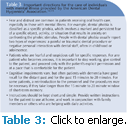
Treating the Mentally Ill
How to effectively provide oral health care services to this rowing populations.
This course was published in the May 2011 issue and expires May 2014. The authors have no commercial conflicts of interest to disclose. This 2 credit hour self-study activity is electronically mediated.
EDUCATIONAL OBJECTIVES
After reading this course, the participant should be able to:
- Discuss the prevalence of mental disorders among the American population
- Identify some of the most common mental disorders.
- List oral symptoms of mental illness.
- Explain strategies for treating patients with mental illness in the general dental practice.
Mental disorders are among the most common causes of disability in the United States and Canada, accounting for 25% of all years of life lost to disability and premature mortality.1 The resulting burden of mental illness is among the highest of all diseases. An estimated 26.2% of Americans ages 18 years and older (more than 60 million people) suffer from a diagnosable mental disorder in a given year. Even though mental disorders are widespread in the population, the main burden of illness is concentrated in a much smaller proportion (about 6% or one in 17) who experience serious mental illness.2-4 Many people suffer from more than one mental disorder at a given time. Nearly half (45%) of those with a mental disorder meet criteria for two or more disorders, with severity strongly related to comorbidity.2
Mental disorders are characterized by alterations in thinking, mood, and/ or behavior that are associated with distress and/ or impaired functioning. Mental disorders contribute to a host of problems that may include disability, pain, and mortality.
PERCEPTIONS OF MENTAL ILLNESS
A fourth year dental student recently approached faculty members for advice about a problem: “I have a patient who is weird, maybe even mentally ill. How do I get rid of her?” Faculty members responded with a question of their own: “How will you handle such an issue when you start private practice next year?”
Oral health professionals are increasingly placed in the same position as the aforementioned dental student. The rise in patients with mental illness needing to be treated in traditional dental practices is caused by a multitude of factors (Table 1 provides a list).
Most people can identify individuals with obvious physical disabilities. Today, more “viewable disabilities” are recognized and necessary accommodations are made whether in school or work settings. But what about those disabilities that are not visible or apparent to the casual observer? People with unseen disabilities often are viewed as not having a disability at all, simply because they do not look out of the ordinary.
TYPED OF MENTAL ILLNESS
In the United States, mental disorders are categorized based on the Diagnostic and Statistical Manual of Mental Disorders, Fourth Edition (DSM-IV). The manual is published by the American Psychiatric Association and covers all mental health disorders for both children and adults. It also lists known causes of these disorders and statistics in terms of gender, age at onset, and prognosis, as well as research concerning the optimal treatment approaches. Table 2 provides a list of common mental disorders.2,3,5-9
TABLE 1. REASONS FOR THE INCREASE OF PATIENTS WITH MENTAL ILLNESS WHO NEED TO BE TREATED IN TRADITIONAL DENTAL PRACTICES.
- Enactment of legislation that eliminates health insurance benefit inequity between mental health/substance use disorders and medical/surgical benefits.
- Deinstitutionalization and mainstreaming of individuals with mental and physical disabilities into community settings. Prior to mainstreaming, many people with mental illness were housed in state institutions.
- The increasing numbers of young people and older adults diagnosed with mental illnesses who are currently being treated by health practitioners in the community.
From 2005 to 2006, serious psychological distress (SPD) among adults was present in 11.3% of the population aged 18 years or older but marked variations existed by state. Utah had the highest rate of SPD among adults (14.4%), while Hawaii had the lowest rate (8.8%). Figure 1 shows the percentages for all states.10 Four states (Arkansas, Missouri, Rhode Island, and Utah) were in the top fifth for both age groups (18 years to 25 years and 26 years or older). Nevada had the highest rate (9.4%) of individuals experiencing a major depressive episode, and Hawaii had the lowest rate (5%).10
ORAL SYMPTOMS ASSOCIATED WITH PSYCHIATRIC DISORDERS
Oral symptoms may be the first or only manifestation of a mental health problem and can include facial pain, preoccupation with dentures, excessive erosion, and selfinflicted injury. Enamel erosion is reported in sufferers of both anorexia and bulimia. Patients with eating disorders also may have increased dental caries, tooth hypersensitivity, margination of restorations, osteoporosis, cardiac abnormalities, muscle cramps, and numerous other health problems.
High rates of psychiatric disorders are reported in patients attending temporomandibular joint (TMJ) dysfunction and specialist pain clinics. Life stressors related to mood disorders may lead to burning mouth syndrome, facial muscle tension, bruxism, etc, which can then result in TMJ dysfunction. In addition, the pain and stress associated with TMJ dysfunction may contribute to mood disorders.11,12
Drug use is associated with significant detrimental psychological, nutritional, and social changes, any of which can affect the general and oral health of the user. Caries can be caused by poor diet, high sugar intake, and the use of methadone in syrup form. There is an increased incidence of periodontal diseases among people with mental illness due to neglect and high incidence of smoking. Trauma and dentofacial injury are common and often untreated.11
Mood, motivation, and behavior are important factors that influence compliance with oral self-care and all aspects of personal hygiene. Lack of interest and low self-esteem associated with mental illness are factors that contribute to inadequate self-care and the regular use of dental health services. Behavior factors may lead to poor compliance, unreliable attendance, and late cancelation of appointments.11
In addition to mood and motivation, the ability to accept dental care is related to selfesteem, ability to think logically, accept and understand the treatment plan, and ability to cooperate with dental treatment. Dementia affects an individual’s ability to accept care. Fear, anxiety, psychotic illness (loss of contact with reality), and dental phobia are significant factors that influence acceptance of dental care.11
Oral and systemic side effects of medications may impede oral health and give rise to patient management problems in planning treatment. The most common side effect is a reduction in salivary secretions or xerostomia. Xerostomia is associated with bulimia; depression; anxiety; systemic diseases, including diabetes and rheumatoid arthritis; dehydration; and radiation treatment to the head or neck region. More than 400 medications, including most psychotropic drugs, cause xerostomia. For the patient with medication-induced xerostomia, effective alternative drugs may be available. The clinical consequences of chronic, untreated xerostomia can be severe, including oral infection, inflamed, fissured tongue, glandular enlargement and infection, rampant caries, and enamel erosion. Temporary symptomatic relief may be obtained from sipping water and from products specifically formulated to relieve dry mouth symptoms, such as mouthwashes, gum, sprays, lozenges, and saliva substitutes.12
 Dyskinesia (difficulty or distortion in performing voluntary movements as in Parkinson’s disease) and dystonia (muscle contractions that cause twisting and repetitive movements or abnormal postures) are possible side effects of the long-term use of anti-psychotic medications and may be characterized by abnormal, involuntary movement of the tongue or facial muscles. These symptoms may pose difficulties in the construction and ability for the patient to manage and control removable appliances.11
Dyskinesia (difficulty or distortion in performing voluntary movements as in Parkinson’s disease) and dystonia (muscle contractions that cause twisting and repetitive movements or abnormal postures) are possible side effects of the long-term use of anti-psychotic medications and may be characterized by abnormal, involuntary movement of the tongue or facial muscles. These symptoms may pose difficulties in the construction and ability for the patient to manage and control removable appliances.11
CARING FOR PATIENTS WITH MENTAL ILLNESS
Clinicians must be flexible in their approach to treatment and appointment scheduling. Patients with mental illness may experience a bad day. They may have forgotten to take their medication or are just noncompliant. They frequently adjust their own doses. They may not be able to emotionally handle the experience and cancel at the last minute or just break the scheduled appointment. They may not be able to handle long procedures.
Prevention must be emphasized. If the clinician needs to prescribe a medication to reduce anxiety, be aware of the effects of taking other drugs. Patients with mental illness often take some medications to help them cope. All medications have peak working times and lengthy procedures could exceed the working time of the drug. The use of epinephrine as a vasoconstrictor in local anesthesia can trigger anxiety and raise blood pressure so it should be avoided.13
As the older adult population grows, increasing numbers of individuals with Alzheimer’s disease will require dental treatment. The prevalence of dental disease likely will be extensive because of diminished salivary flow and patients’ inability to perform appropriate oral hygiene techniques. Preventive dental education for the caregiver and use of saliva substitutes and anticaries agents are indicated.14 
Table 3 lists other helpful management tips provided by the American Dental Hygienists’ Association.12,15
THE CHALLENGE
People with serious mental disorders who are receiving treatment through outpatient care have a much easier time accessing general health care than they do dental care. Many barriers remain for these patients to access oral health care services.16
As a consequence of deinstitutionalization and mainstreaming, individuals with mental illness increasingly are dependent on community dental facilities for care. In reality, many of these individuals are members of families currently being treated in dental practices. Dentists, dental hygienists, dental assistants, and supportive staff members need to be prepared for these patients, both in terms of an awareness of the particular conditions, their effects on the oral cavity, and how best to proceed with the needed care.
REFERENCES
- World Health Organization (WHO). Annex Table 3: Burden of disease in DALYs by cause, sex, and mortality stratum in WHO regions, Estimates for 2002. Available at: www.who.int/whr/2003/en/Annex3-en.pdf. Accessed April 20, 2011.
- Kessler RC, Chiu WT, Demler O, Merikangas KR, Walters EE. Prevalence, severity, and comorbidity of 12-month DSM-IV disorders in the National Comorbidity Survey Replication. Arch Gen Psychiatry. 2005;62:617-627.
- National Institute of Mental Health. The numbers count: mental disorder in America. Available at: www.nimh.nih.gov/health/publications/the-numbers-count-mentaldisorders-in-america/index.shtml. Accessed April 20, 2011.
- Healthy People. Mental health. Available at: www.healthypeople.gov/2020/topicsobjectives2020/overview.aspx?topicid=28. Accessed April 20, 2011.
- American Psychiatric Association. Diagnostic and Statistical Manual of Mental Disorders, Fourth Edition (DSM-IV). Washington, DC: American Psychiatric Press; 1994.
- Psychiatric disorders. Available at: http://allpsych.com/disorders/dsm.html. Accessed April 20, 2011.
- National Institute of Mental Health. Attention-Deficit/Hyperactivity Disoder Among Adults. Available at: www.nimh.nih.gov/statistics/1ADHD_ADULT.shtml. Accessed April 28, 2011.
- National Institute of Mental Health. Autism. Available at: www.nimh.nih.gov/statistics/1AUT_CHILD.shtml. Accessed April 28, 2011.
- National Institute of Mental Health. Eating Disorders. Available at: www.nimh.nih. gov/health/topics/eating-disorders/index.shtml. Accessed April 28, 2011.
- US Department of Health and Human Services. Mental health problems. Available at: http://oas.samhsa.gov/2k6State/Ch6.htm#. Accessed April 20, 2011.
- British Society for Disability and Oral Health. Oral health care for people with mental health problems: guidelines and recommendations. Available at: www.bsdh.org.uk/guidelines/mental.pdf Accessed April 20, 2011.
- American Dental Hygienists’ Association. Psychiatric Disorders—Practical Aspects. Available at: http://www.adha.org/CE_courses/course10/psychiatric_ disorders.htm Accessed April 20, 2011.
- Bricker SL, Langlais RP, Miller CS. Oral Diagnosis, Oral Medicine, and Treatment Planning. 2nd ed. Hamilton, Ontario: BC Decker Inc; 2002:218.
- Friedlander AH, Norman DC, Mahler ME, Norman KM, Yagiela JA. Alzheimer’s disease: psychopathology, medical management and dental implications. J Am Dent Assoc. 2006;137:1240-1251.
- Cormac I, Jenkins P. Understanding the importance of oral health in psychiatric patients. Advances in Psychiatric Treatment. 1999; 5:53-60.
- Dickerson FB, McNary SW, Brown CH, Kreyenbuhl J, Goldberg RW, Dixon LB. Somatic healthcare utilization among adults with serious mental illness who are receiving community psychiatric services. Med Care. 2003;41:560-570.
From Dimensions of Dental Hygiene. May 2011; 9(5): 56-59.



